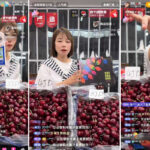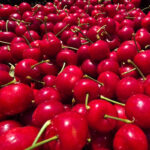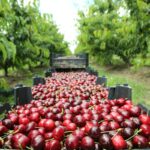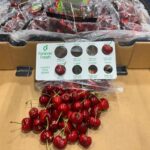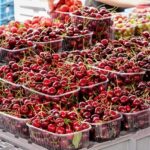Chinese tariffs to put U.S. cherry export growth under strain

More than half of the US$226 million in U.S. fresh fruit exports to mainland China last year came from cherries, having grown more than four-fold since 2013. But this phenomenal growth rate is now under pressure with sweet cherries set to be collateral damage in a sour trade dispute. Slogged with a new 15% tariff on top of existing import duties and VAT, growers and exporters express their concerns to Fresh Fruit Portal.
“If it is in a seller’s market, the buyer will absorb it. If it is a buyer’s market, the seller has to absorb it,” says Auvil Fruit Company export sales manager Bin Zhang, taking a philosophical approach to the question of who will bear the brunt of these tariffs.
Exporters can take some solace in the fact the U.S. dollar has fallen 8% against the renminbi over the past 12 months, making them more competitive, but Zhang highlights the market is constantly changing with ever more imports and growing domestic Chinese production.
So in the absence of a weather disaster that damages crops in the U.S. Pacific Northwest, or an unexpected surge in cherry demand, all signs are pointing to a buyer’s market when the season starts in over two months’ time.
“My biggest concern for the summer is the cherries because Washington has so many cherries – last year we shipped several million boxes to China,” says Zhang.
According to producer organization Northwest Cherry Growers, exports to mainland China and Hong Kong reached 3.2 million 20lbs boxes in 2017, equating to roughly 33,000 metric tons (MT) and returns of US$140 million.
“I think the tariff will definitely have some kind of impact on the 2018 season but at the moment it’s hard for us to gauge just how severe the impact might be,” says Northwest Cherry Growers’ director of international operations, Keith Hu.
“I have been speaking with key retail partners and importers in China and they’re still going to import as many cherries as they can.” Hu says.
“But one key point that we all agreed on is that if the growers can provide good quality cherries into China this summer I think we could weather it okay and keep the impact at a minimum. But then it will be a different story if the quality is sub-par. So quality will be the big issue this year.”
He emphasizes the U.S. cherry export industry has the sorting technology needed to select the finest fruit for the Chinese market, and if any exporters opt to ship sub-par product the risk of incurring losses will be high.
“Right now with the 15% tariff, that’s on top of really 10% import duty and 13% VAT so we’re looking at over 38% tax on cherries,” he says.
“Price for sure is going to be an issue, and with sub-par standard cherries and a high price that’s a challenge that we don’t want.
“I personally don’t foresee a complete disaster to China, but the industry, my organization, needs to push harder in other markets like Taiwan, Korea and Southeast Asia to absorb the possible reduction of Chinese sales.
Uncertainty is a predominant theme for the cherry industry as it prepares for the next harvest and exporters do the best they can to keep their foothold and strong relationships in China.
“We’ve still got almost 2.5 months to go and who knows what will happen in 2.5 months. The [trade] war could be over by then or it could completely shut out all U.S. product,” says Hu.
Chelan Fresh general sales manager Tim Evans echoes Hu’s comments on ensuring quality as the be-all and end-all for exports this season.
“Any time price goes up for a consumer that’s worrisome. It may impact what the grower return looks like but we’re confident given the right quality that China will remain a good market,” Evans says.
“But it is burdensome to think about another 15% being added on to the cost to the end user, the consumer. It’s really about quality and making sure that we ship the very best product.
“We’re in the earliest stage of bloom in some of the earliest varieties in some of the earliest sites, so we remain optimistic but I think the 20 plus million box crops are here to stay out of the Pacific Northwest.”
At around 26 million boxes, the region's growers hit record production levels last year. The early indications right now are that volume may not be that big in 2018, but it could still be large and perhaps have bigger sizing, depending on weather conditions.
“We had a kind of medium, small-sized fruit profile last year so hopefully that’ll improve this year as well,” adds Evans, also mentioning his company exports around 25% of its crop.
“It’s really about satisfying the consumer and making sure we have the right product to ship to China. That’s the important part – if we can do that I think we’ll maintain decent returns to growers.”
Domex Superfresh Growers director of international business development Jeff Webb highlights strong growth for fruit exports to China in recent years, including the introduction of club varieties.
"We don't want to have that interrupted right now. That’s what this thing is doing right now," he says.
Tariffs or no tariffs, Domex is pushing on with its plans to introduce a new cherry variety to the Chinese market this year. Webb is not able to reveal its name just yet, but says it is a late cherry with good output per acre, a sweet flavor, and a hardiness that makes it store well.
"We proceed as normal. We target our customers based on the customer demands and needs, and we try to work better numbers and larger numbers. It's not like we’re going to pull out of the market and go to another country. We’ll do what we do every day," he says.
"In China cherries are a very highly valued piece of fruit. I don’t think they’re going to get to a point where they can only take half of the volumes.
"It’s just that they’re going to have to increase prices to the consumer and possibly even a combination of lower returns back to the grower because of this."
Webb is also emboldened by the positive results of Chile's cherry industry in the Chinese market this past season despite a massive hike in volume.
"Watching what happened with Chile with the literal doubling of their shipments to China, prices did go down for them but they were able to absorb an extraordinary amount of fruit and with high success," Webb adds.
"Yeah prices did come down but they didn’t really come down until the end of it when quality got bad and after the Chinese New Year."
Orchard View Farms vice president Ken Bailey says around 15-20% of his company's crop is normally exported to China. One of his worries this year is not only the impact tariffs could have on returns from China, but also the flow-on effects elsewhere.
"We’re pretty time sensitive on fresh cherries for any market you can get to keep your movement up and prices up. As soon as one starts cutting back, the prices tend to go down," he says.
"And if you can’t make the sale you have to sell somewhere else and that can reduce your prices.
"The Northwest as a whole is trying to find as many markets as we can and we’ve been doing that almost every year - it basically means shuffling.
"You're not looking for more markets but you’re looking for markets you already have to take more fruit, moving from one to another because there are not a lot of new places you can develop in a hurry because of the refrigeration and transportation needs."
Bailey, whose company is based in Oregon, believes this year's crop will be 10-20% down on the 2017 record harvest, but that's still a massive volume of cherries. He isn't happy about the fact the industry can do very little right now to change the diplomatic circumstances, but he remains hopefully the tide will turn.
"It’s hopeful that something will happen in the economy or something in the next few weeks to get him [President Donald Trump] change his mind," he says.
"We spent many years getting the tariff to where we’re at. We weren’t totally happy with everything as we went along but it’s been improving and we got ourselves into a pretty decent position.
"This just blows many years of negotiations and trade deals clean out of the water, and we need to start again. So hopefully we can get it back to normal pretty quickly but I guess realistically it could even take years to get back to normal again."
Photo: NW Cherries
















